With COVID-19 still plaguing societies worldwide, flexible work arrangements remain ubiquitous in the current business landscape. Even though some employees have returned to the office, a lot of enterprises are expected to rely on remote work until the pandemic is curtailed. This has caused a change in the way companies view work and their workforce.
As such, many of the remote work software trends established at the height of the pandemic are likely to continue. Flexible work hours and arrangements will remain popular. And the same goes for the use of video conferencing tools and remote productivity tracking. Efforts to reduce stress and fatigue will also be in place, given that virtual workspaces have encroached on what was once considered a place for rest and leisure.
To give you a clearer picture, this article will discuss the latest trends in detail.

Remote Work Software Trends Table of Contents
- Remote Work Arrangements as the New Norm
- Hybrid Work Models
- More Flexible Working Hours
- Adoption of Cloud-Based Tools
- Upskilling and Training Expected by Employees
- Asynchronous Communication
- Zoom as a Remote Work Staple
- Greater Need for Cybersecurity Measures
- Increased Emphasis on Time and Productivity Tracking
At first, remote work was considered a temporary solution for employees to be productive while being protected from COVID-19. However, as the pandemic continued to rage on, workers and companies found comfort and garnered satisfactory results from the arrangement, respectively. This led to a greater acceptance of remote work, which is likely to continue after the pandemic.
According to a 2021 survey, 73% of the global workforce prefer to retain the remote work option post-COVID-19 (Microsoft, 2021). Concurrently, 66% of companies are considering remodeling their offices to make them more conducive for hybrid work. With both sides finding common ground in remote work, the setup persisted through the latter half of 2021.
Expected Outcomes of Hybrid Work Post Covid-19
Employees who want flexible work options to remain: 73
Employees who want flexible work options to remain
%Employees who prefer in-person work and/or collaborations post-pandemic: 67
Employees who prefer in-person work and/or collaborations post-pandemic
%Companies considering redesigning offices for hybrid work: 66
Companies considering redesigning offices for hybrid work
%Source: Microsoft 2021
Designed byHowever, remote work is not without its challenges, spurred by the fact that it is harder to monitor a remote workforce. There may also be gaps in communication and technical requisites for operations to run smoothly. But a host of software solutions that address these concerns have been deployed by businesses globally, from video conferencing to time tracking. This drove organizations to see remote work as a viable mode of operations.
As a testament to remote work’s worth, 23% of employees are willing to have their salaries reduced by over 10% just to work from home. Meanwhile, businesses will deal with lower utility costs and have the flexibility to reduce office space and technical requirements as they see fit. The following trends further explore how remote work will change previous norms.
17 Significant Remote Work Software Trends
1. Remote Work Arrangements as the New Norm
Economies have reopened to recover from the effects of the pandemic such as unemployment and low economic returns. However, for recovery to take place without exposing employees to health risks amid the pandemic, remote work arrangements will have to be retained. Based on the numbers, distance working could stick even after the pandemic.
In a 2021 report by Gitlab, it was revealed that employers experienced a 42% increase in productivity, 38% in efficiency, 31% in employee morale, and 30% in employee loyalty and retention from adopting remote work policies (Gitlab, 2021). On top of these, companies also got to enhance communications and even a reduction in their carbon footprint. Such gains lead to a significant increase in operational efficiency and rate of returns with or without a pandemic.
As of April 2021, 67% of US companies have remained fully remote while 27% maintain hybrid arrangements and 6% mandate on-site operations (Deloitte, 2021). An increased share of businesses is expected to compel their workforce to return to the office but remote work will still be the dominant arrangement. Moreover, it will probably become a permanent option in many industries in the long run.
Source: Gitlab 2021
Remote Work Arrangements as the New Norm Highlights:
- 67% of US companies have remained fully remote while 27% maintain hybrid arrangements and 6% mandate on-site operations.
- With remote work, employers experienced a 42% increase in productivity, 38% in efficiency, 31% in employee morale.
- Companies also experienced enhanced communication and a reduced carbon footprint.
2. Hybrid Work Models
As nations find better ways to contain the coronavirus, the likelihood of organizations shifting from a remote setup to a hybrid one becomes higher. The global economy is projected to recover by 5.9% in 2021 (Congressional Research Service, 2021), as a lot of countries have reopened their economies, with looser restrictions across most sectors. In line with this, many companies have opted to adopt hybrid work arrangements. Many businesses have followed suit since, making the hybrid model the most prevalent among remote work software trends for 2022.
Delving further into the landscape, 61% of the US workforce is expected to work remotely for one day per week in the future, 17% for one to two days, and 22% for three to five days (McKinsey, 2021). Other developed countries like Japan, France, Germany, and the United Kingdom share the same or have a similar breakdown.
The rationale behind employing a hybrid model is to leverage the advantages of both remote and office work. While the benefits of remote work are significant, adopting a hybrid setup reduces burnout, improves communications in some regards, and increases employee visibility. Considering all these, the arrangement results in engaged and more motivated workers and managers.
Hybrid Work Models Highlights:
- 61% of the US workforce is expected to work remotely for one day per week.
- COVID vaccinations have been rolled out, leading to the return of more workers to the office.
- Adopting a hybrid setup reduces burnout, improves communications in some regards, and increases employee visibility.
3. More Flexible Working Hours
The adoption of remote and hybrid models paves the way for a more flexible schedule for employees. Even though the number of work hours is unchanged for 80.3% of US employees (United States Census Bureau, 2021), remote workers can take timely breaks outside their designated window in an office setting. In doing so, they can clear up their headspace to process more information as needed.
It is important to note that a flexible work arrangement does not always lead to a flexible schedule. If we look at the post-pandemic numbers, a staggering 9 out of 10 employees want more flexibility at work (WCI, 2021). Moreover, 54% of employees prefer to have more flexible working hours, higher than the share of those longing for flexibility in work location (40%).
As such, the future of remote work is loud and clear in this regard, or else employers will have to deal with a highly fatigued workforce. After all, a home office bears its share of kinks not found in its traditional counterpart.
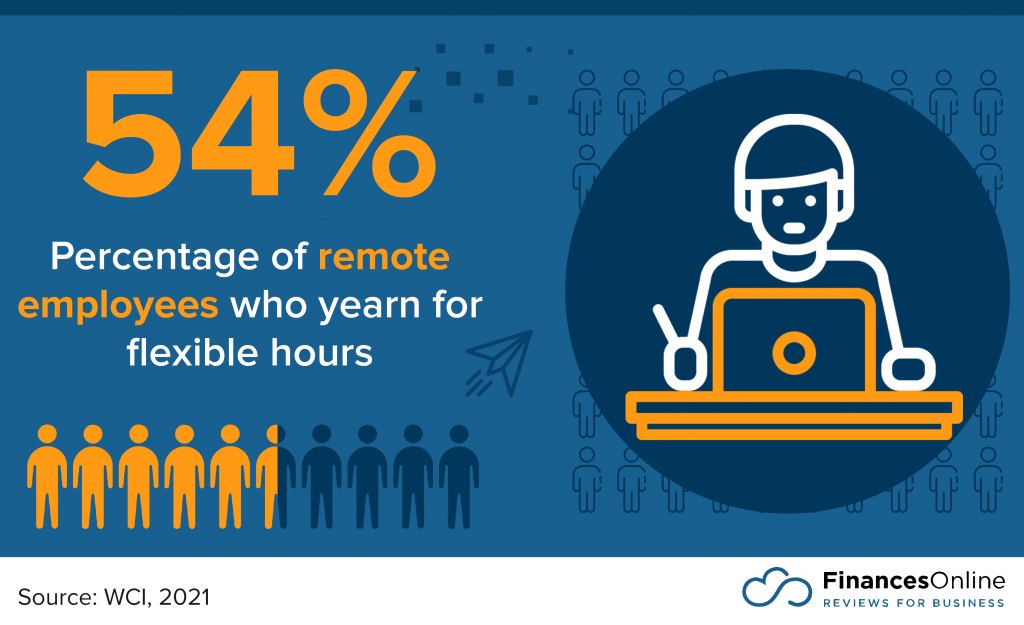
More Flexible Working Hours Highlights:
- 9 out of 10 employees want more flexibility at work.
- In addition, 54% of employees prefer to have more flexible working hours.
- Flexible working hours can help reduce stress and boost productivity.
4. Adoption of Cloud-Based Tools
The days of office tools being strictly confined to the physical workspace may be numbered, given the importance of remote work during the COVID-19 pandemic. At a time when companies need more business to avoid bigger losses or closure, the need for cloud-based tools is heavily underscored. Consequently, this has influenced the investments of modern business leaders.
As the figures behind the remote work software trends post-COVID suggest, 72% of US executives plan to invest in virtual collaboration tools (including cloud-based platforms) while 70% intend to inject more funds to beef up their IT infrastructure for improved connectivity (PwC, 2021). These foster the portability of jobs, thus allowing employees to work on their deliverables at home or any space that has a stable internet connection.
Many US firms have already started the cloud-based trend. Usage of the public cloud has increased by 71%, and the same goes for modern apps (58%) and SaaS (51%) (VMware, 2021). The flexibility afforded by cloud-based tools would likely make them popular even after the pandemic.
Business Areas with Increased Usage Due to COVID-19
Remote Workforce: 72
Remote Workforce
%Public Cloud: 71
Public Cloud
%Modern Apps: 58
Modern Apps
%SaaS: 51
SaaS
%Source: VMware 2021
Designed byAdoption of Cloud-Based Tools Highlights:
- 72% of US executives plan to invest in virtual collaboration tools.
- Meanwhile, 70% intend to inject more funds to beef up their IT infrastructure for improved connectivity.
- In addition, the usage of the public cloud has increased by 71%.
5. Upskilling and Training Expected by Employees
Conventional training and upskilling will have to evolve if they are to suit the needs of companies and their remote staff. Besides the digitization of training modules and the use of video conferencing for face-to-face training, the content will need several inclusions, particularly skills that target remote working needs.
In a recent survey, hard skills training came out as the most requested training type, with 80% of remote workers clamoring for it, followed by soft skills training (53%), COVID-19 training (39%), and compliance training (32%) (TalentLMS, 2021). As far as the demand is concerned, 78% of remote workers want it and 61% believe that they will become better in their roles due to it.
Meanwhile, in regard to upskilling, 49% of companies consider service training to be the most critical, higher than knowledge training (47%) and physical training (36%) (SHRM, 2021).
In addition to skills training, some companies also include cybersecurity training programs because remote work heightens cyberattack risks. As of the latest data, 32% of organizations conduct it twice a year; 25% hold it annually; 23% administer it more than twice a year (OpenVPN, 2021).
Effective training programs bring forth positive outcomes, making them some of the most relevant remote work trends in today’s business landscape. 72% of employees who received training reported improvements in productivity while 69% became better at time management, and 65% fostered better communication with coworkers (TalentLMS, 2021).
Source: TalentLMS 2021
Upskilling and Training Expected by Employees Highlights:
- 78% of remote workers who haven’t received training want it.
- Additionally, 61% believe that they will become better in their roles due to training.
- 80% of remote workers want hard skills training the most.
6. Asynchronous Communication
Communication is a vital cog in any profession and digitizing such is what makes remote work possible. If we peek at the numbers, communication technology is the area in which employers help their workforce the most, as 26% of companies grant remote employees better access to it (Clutch, 2020).
Managers recognize this but they tend to forget that not everyone on the team shares the same schedule or works in the same part of the world. In fact, a glaring 62% of team calls and meetings are unplanned and unstructured (Microsoft, 2021).
Asynchronous communication enters the picture by eliminating the need to respond as soon as a message or demand is sent to employees. It grants workers the space they need to prioritize tasks and make a response within their shift. Additionally, it alleviates concerns caused by proximity. After all, 74% of remote workers disclosed that some members of their team are in different time zones (Lighthouse Blog, 2021).
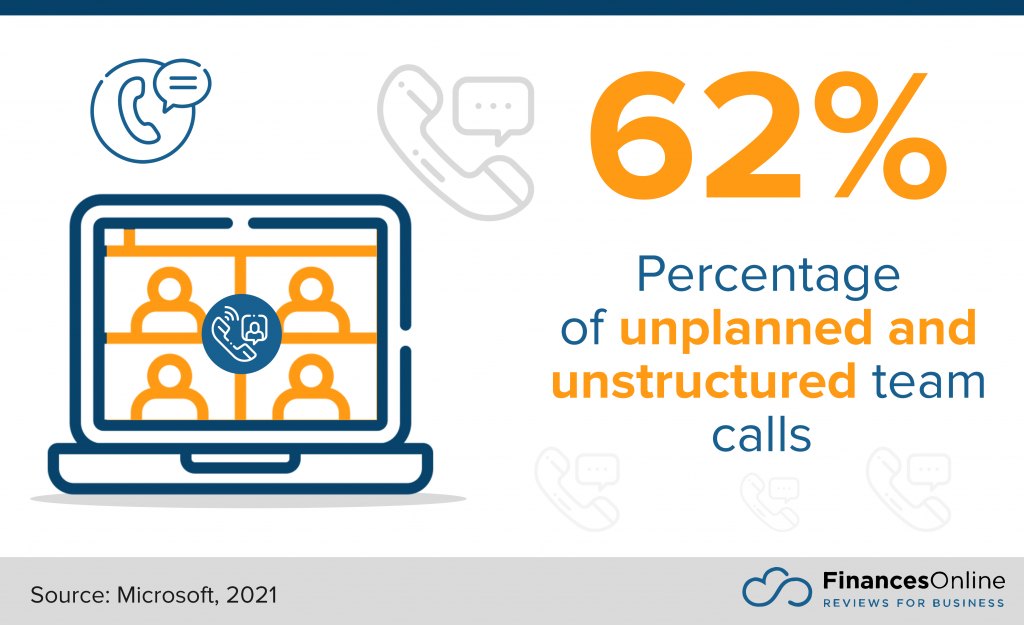
Asynchronous Communication Highlights:
- 62% of team calls and meetings are unplanned and unstructured.
- Also, 74% of remote workers disclosed that some members of their team are in different time zones.
- As such, asynchronous communication helps by eliminating the need to respond as soon as a message or demand is sent to employees.
7. Zoom as a Remote Work Staple
Tiktok may have become the world’s hottest app since the pandemic but during work hours, Zoom’s dominance is unparalleled. In 2020, it was the world’s most downloaded non-social-media application with 477 million installs, more than Facebook Messenger, Snapchat, and Netflix (Business of Apps, 2021). What’s more, the app’s usage grew by an astonishing 3,300% in October 2020 compared to the previous year (Backlinko, 2021).
Zoom has become the remote replacement for office meetings, gatherings, and even parties. Partly due to the app’s convenience, the time spent on meetings grew by 148% from February 2020 to February 2021 (Microsoft, 2021). This comes as a double-edged sword for the workforce. On the one hand, meetings can take place at any location with an internet connection. And on the other, the ubiquity of online meetings has led to “Zoom fatigue.”
Research suggests that workers who take too many video calls become less collaborative (Forbes, 2020). To avoid this, managers should mix up the modes of communication and rely on video conferencing for complex discussions of those that require demonstrations. They should also try to confine video conferences within work hours.
In any case, Zoom has become an integral element of any modern business.
Most Popular Apps in the US in 2020, by Downloads
(in millions)
TikTok: 89
TikTok
Zoom: 81
Zoom
Instagram: 62
Messenger: 61
Messenger
Facebook: 53
Cash App: 52
Cash App
Snapchat: 51
Snapchat
Disney+: 45
Disney+
WhatsApp: 45
Netflix: 45
Netflix
Source: Business of Apps 2021
Designed byZoom as a Remote Work Staple Highlights:
- In 2020, Zoom was the world’s most downloaded non-social-media application with 477 million installs.
- Zoom’s usage grew by an astonishing 3,300% in October 2020 compared to the previous year.
- Unfortunately, the ubiquity of online meetings has led to “Zoom fatigue.”
8. Greater Need for Cybersecurity Measures
Without the protection of office network security, the personal devices remote workers use are more exposed to cybersecurity threats than office computers—and cybercriminals are taking advantage of this fact. According to a 2021 study by Tenable, 74% of organizations cite remote work tech vulnerability as a cause of recent cyberattacks (Tenable, 2021). What’s more, 71% of security officers admit that they do not have the capacity to cover remote employee networks, which is why 67% of cyber attacks are aimed at remote workers.
This heavily underscores the need for more sophisticated cybersecurity measures, and a lot of enterprises have responded to the call. In Tenable’s survey, 66.67% of business leaders disclosed that they plan to increase their cybersecurity investments in the next couple of years, nearly 75% of whom named cloud security and vulnerability management as top priorities.
The trend of beefing up cybersecurity will become the norm soon given that 98% of remote workers use a personal device for work daily.
Greater Need for Cybersecurity Measures Highlights:
- 74% of organizations cite remote work tech vulnerability as a cause of recent cyberattacks.
- What’s more, 71% of security officers admit that they do not have the capacity to cover remote employee networks.
- 67% of cyber attacks target remote workers.
9. Increased Emphasis on Time and Productivity Tracking
Common problems for employers during the pandemic are monitoring the attendance, active times, and productivity of the workforce. These concerns are not unfounded as the US economy loses 50 million productive hours daily, equating to a loss of $7.4 billion per workday (Market Research Future, 2020). Thankfully, the software realm presents ideal solutions to these concerns.
Time tracking software allows employers to remotely monitor the daily attendance, productive hours, and visited sites of employees. Meanwhile, project management platforms enable managers to plan, collaborate, and delegate, monitor, and schedule tasks online. Both program types have been gaining more traction since the pandemic for the conveniences they provide.
The global time tracking market size grew from $121.56 million in 2020 to $130.72 million in 2021 and is projected to reach $191.51 million by 2026 (ReportLinker, 2021). Likewise, the project management software market is expected to financially expand from $5.37 billion in 2020 to a projected $9.81 billion by 2026 (Research and Markets, 2021).
Source: ReportLinker 2021, Research and Markets 2021
Increased Emphasis on Time and Productivity Tracking Highlights:
- The US economy loses 50 million productive hours daily.
- This equates to a loss of $7.4 billion per workday.
- With this, the global time tracking market size is projected to reach $191.51 million by 2026.
10. Shift in Performance Management Strategies
Since today’s workspaces have gone virtual, a company’s performance management strategies should follow suit. And it has to some extent, thanks to online solutions like project management software and video conferencing. A lot of firms now carry a more progressive stance on remote work and performance management. The numbers point to the efficacy of digitalization in both regards.
According to a 2021 survey by Engagedly, more than 50% of businesses stated that their workforce more frequently participates in performance reviews, alignments on objectives and key results, and the like (Engagedly, 2021). In addition, 64.8% of companies experienced a spike in engagement in regard to check-ins with managers. Moreover, 73.8% of businesses said that their digital initiatives will persist even after COVID-19.
A foremost reason for the success of virtual performance management is real-time feedback. Instead of waiting for reviews or appraisals, a company’s staff receives feedback while on the job or shortly after. This enables them to imbibe the manager’s recommendations while the information is still fresh in their minds. In the same way, managers won’t overlook certain aspects of a staff member’s performers since feedback is given in real-time.

Shift in Performance Management Strategies Highlights:
- A lot of firms now carry a more progressive stance on remote work and performance management.
- Over 50% of businesses stated that their workforce more frequently participates in performance reviews.
- In addition, 64.8% of companies experienced a spike in engagement in regard to check-ins with managers.
11. Evolved HR Practices
Remote work opens up opportunities for professionals to seek gainful employment across the globe. Behind this initiative are human resources departments that are obliged to adapt to the current working standards. It seems it will remain this way for as long as remote and hybrid work continue to be the dominant arrangements.
HR departments are now more open to hiring staff from outside a nation’s borders. In fact, 31% of HR and business leaders state that over 50% of global employees are expected to have temporary remote work arrangements in a year (PwC, 2020). This vastly expands the recruitment pool for companies that need new staff.
Global hiring is not the only area of adjustment for HR departments. Work requirements have also evolved, from the technical know-how in handling work tools to creating benefits packages that are helpful to remote workers. Moreover, safety measures have been enforced for staff returning to the office. As far as candidate interviews are concerned, 65% of companies intend to use video conferencing (SHRM, 2020).
The transformation of HR departments during the pandemic has made companies more reliant on them. Currently, 87% of HR professionals report that their work has been crucial to the success of their employers since the beginning of the pandemic (SHRM, 2020). In addition, 51% of HR professionals believe that their work is more appreciated compared to pre-pandemic times.
HR Outcomes in the COVID-19 Era
Source: SHRM 2020, PwC 2020
Designed byEvolved HR Practices Highlights:
- 65% of companies intend to use video conferencing for job interviews.
- Furthermore, 31% of HR and business leaders state that over 50% of global employees are expected to have temporary remote work arrangements in a year.
- 87% of HR professionals report that their work has been crucial to the success of their employers since the pandemic began.
12. Growing Popularity of Virtual Coffee Breaks
Office work is not all about submitting documents and satisfying clients. Time is allotted for teams to bond daily, and it usually takes place during one’s coffee break. Remote work will not be all too different in the near future as digital teams have ported these leisurely moments over to their laptops and mobile devices via video conferencing.
Virtual coffee breaks typically last for around 15 to 30 minutes (TeamBuilding, 2021) and can be anything, from caffeinated discussions to fun trivia games. These interrupt the monotony of producing reports and other documents, allowing workers to unwind and clear their headspaces. Moreover, these breaks reconnect employees with the coffee culture in the office, along with the fun times associated with it. After all, 67% of employees always or often consume coffee at work (Ten Spot, 2021).
More importantly, a virtual coffee break helps the workforce avoid or address burnout. According to a survey by TINYpulse, 85.65% of remote workers and 80.87% of hybrid workers experience emotional exhaustion (TINYpulse, 2021). Coffee, as a stimulant, happens to recharge people and raise engagement, more so if taken with friends.
Source: TINYpulse 2021
Growing Popularity of Virtual Coffee Breaks Highlights:
- 67% of employees always or often consume coffee at work.
- 85.65% of remote workers and 80.87% of hybrid workers experience emotional exhaustion.
- With this, virtual coffee breaks allow workers to unwind, clear their headspaces, and bond with their teams.
13. Increased Use for Coworking Spaces
For many employees, remote work is an exercise in isolation as they experience the highs and lows of their jobs alone, most probably in their rooms. Should they go down the same path for long, the routine can cause them to lose their interest in work or worse, develop a mental health condition. A way out of this cycle is to settle in a coworking space during work hours now that COVID-19 vaccines have been rolled out. What’s more, coworking spaces may also benefit employers.
The use of coworking spaces has left a favorable impression on remote workers. 71.5% of pre-pandemic users intend to return soon while 54.9% of remote employees who have never used a coworking space plan to work in one in the future (Allwork Space, 2021). Meanwhile, small companies looking for a hybrid office can take advantage of the flexible leases, with landlords apportioning 10% to 25 % of their assets to such. They can afford to reduce their office space due to remote work and take refuge in a coworking space temporarily.
As a testament to this trend, the global coworking spaces market is expected to grow by $13.35 billion from 2021 to 2025, with an annual growth rate of more than 11% (Research and Markets, 2021).
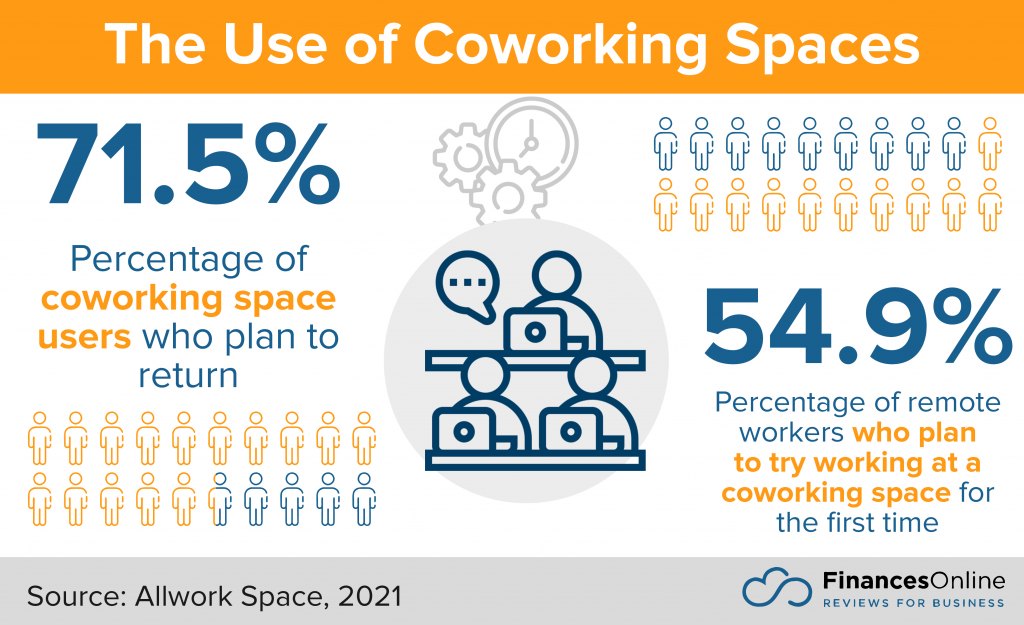
Increased Use for Coworking Spaces Highlights:
- The global coworking spaces market is expected to grow by $13.35 billion from 2021 to 2025.
- 71.5% of pre-pandemic coworking space users intend to return soon.
- Meanwhile, 54.9% of remote employees who have never used a coworking space plan to work in one in the future.
14. Reduced Office Spaces
The price of rent is directly proportional to the size of an office. So, companies with bigger offices have to deal with higher costs, a fact that broke budgets at the height of the pandemic. Fortunately for businesses, remote work has become a widely acceptable arrangement. This allows firms to decrease office space to limit costs while negotiating more forgiving terms with tenants.
As such, one in five businesses plans to reduce its office space after a successful transition to remote work (Los Angeles Times, 2021). In addition, these companies intend to decrease their office space by 10% to 24% over a 12-month period. The same trend can be seen in New York where office vacancy rates rose to 11.7% in 2020 (Harvard Business Review, 2021).
This does not mean, however, that it is okay to forgo an office in favor of a purely remote workforce. Having a physical office still has its share of benefits, foremost of which are employee monitoring and direct communication. But, as the current trends suggest, more companies are redesigning their offices for hybrid work instead of maintaining a space that houses the entire workforce (Microsoft, 2021). It’s an economically sound move for many.

Reduced Office Spaces Highlights:
- One in five businesses plans to reduce its office space after a successful transition to remote work.
- These companies intend to decrease the space by 10% to 24% over a 12-month period.
- Moreover, office vacancy rates in New York rose to 11.7% in 2020.
15. Higher Standards for Work-Life Balance
A common concern about remote work is the encroachment of the workspace, along with the professional mindset, into a space that is often associated with rest and leisure. Thus, remote workers have a tendency to take in more stress and work-related anxiety due to the lack of substantial rest.
A 2021 study reveals that the inability to unplug from work-related technology was the biggest problem faced by a remote workforce, with 27% of employees admitting to it (Buffer, 2021). Other struggles include difficulties in collaboration (16%), loneliness (16%), distractions at home (15%), and staying motivated (12%).
Furthermore, the heavy workloads of remote workers are not doing them any favors. The duration of meetings has gone up by 148% while the volume of emails delivered from 2020 to 2021 increased by 40.6 billion (Microsoft, 2021). Likewise, document-based deliverables and weekly team chats have increased by 66% and 45%, respectively.
Leaving these concerns unaddressed can result in burnout and unmotivated employees. Mental health problems may also develop among the workforce should companies not promote a healthier work-life balance. They likely will as a disengaged workforce affects a company’s reputation and returns.
Source: Buffer 2021
Higher Standards for Work-Life Balance Highlights:
- 27% of employees admit to not being able to unplug from work.
- The duration of meetings has also gone up by 148%.
- In addition, the volume of emails delivered from 2020 to 2021 increased by 40.6 billion.
16. Mental Health Concerns Due to Remote Work Environments
Remote work can be a lonely exercise, especially in professions that center on individual performance more than a team’s. Prolonged stretches of isolation can lead to mental health concerns like depression, demotivation, and the inability to rest. In lieu of this, mental health problems have become nearly as prevalent as remote work itself. In fact, 76% of employees report having at least one symptom of a mental health condition (Harvard Business Review, 2021).
Thankfully, a lot of employers have responded to this by offering mental health services to their workers. Fifty-four percent of employees disclosed that the companies they work for have become more considerate of their mental health needs (American Psychiatric Association, 2021). In addition, one in five employers provides mental health services. Unfortunately, one in four employees bared that they fear retaliation if they seek help or take time off due to a mental health concern.
Clearly, mental health support is still a work in progress in the professional sphere. But many organizations have taken a step in the right direction in dealing with mental health conditions. And the support services they offer are expected to improve over time.
Mental Health Outcomes of Remote Work
Source: Harvard Business Review 2021
Designed byMental Health Concerns Due to Remote Work Environments Highlights:
- 76% of employees report having at least one symptom of a mental health condition.
- It’s a good thing that 54% of employees disclosed that the companies they work for have become more considerate of their mental health needs.
- One in five employers provides mental health services.
17. More Diverse Talent Pools
With the advent of remote work due to the pandemic, companies have expanded their talent pools as they hire staff from various corners of the globe. In fact, 33% of businesses have initiatives for hiring domestic and international workers (PwC, 2020). To support this setup, 72% of companies are looking to make new investments in tools for virtual collaboration. Doing so offsets the challenges posed by proximity and the difference in time zones.
Furthermore, hiring skilled workers from developing countries increases the savings of companies from developed economies. The cost of living in many developing nations is considerably lower and so are the standard salaries, thus employers from developed nations can fill in occupancies at lower costs. Many developing economies also embed English into their school curricula, so finding English speakers and writers won’t be a problem.
As such, hiring globally has been a prevailing trend even before COVID-19, and it will continue to be one after the pandemic.
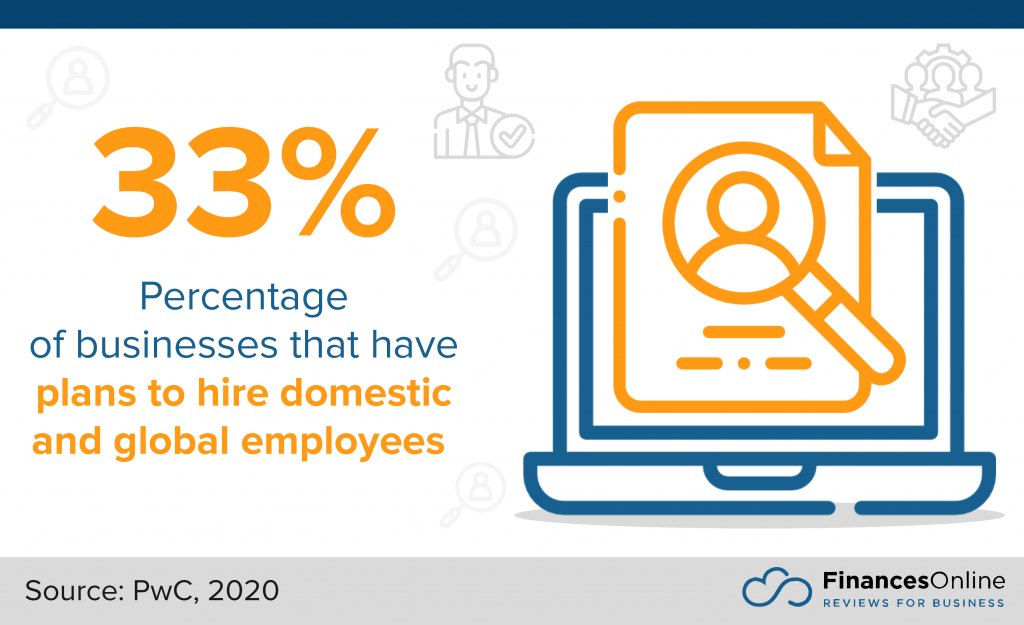
More Diverse Talent Pools Highlights:
- 33% of businesses have initiatives for hiring domestic and international workers.
- Hiring skilled workers from developing countries increases the savings of companies from developed economies.
- Many developing economies also embed English into their school curricula, so finding English speakers and writers won’t be a problem.
The Future of Work is Remote
Remote work has become the arrangement of choice for most organizations since the COVID-19 pandemic began, and for a good reason. It keeps employees safe while keeping business operations running. As business needs evolve, so does the face of remote work. With the COVID vaccines rolled out, a shift to a hybrid work arrangement is inevitable. In this way, companies and their employees can leverage the benefits of both office and remote work.
Moreover, operational changes in areas like cybersecurity, training, and the use of software will be applied. These changes remedy concerns on data breaches, skill gaps of workers, and operational efficiency, respectively. Finally, mental health services will see a boom since remote workers tend to feel overworked and isolated. Companies are also expected to come up with better initiatives to promote a healthy work-life balance. At the end of the day, they recognize that having inspired and engaged employees lead to higher returns.
After learning about the latest trends, you might want to know how to properly leverage remote work. If so, you can read our guide on remote work best practices. It can help your remote team successfully adjust to working from home without sacrificing productivity and their mental health.
References:
- American Psychiatric Association (2021, May 20). As Americans Begin to Return to the Office, Views on Workplace Mental Health Are Mixed. American Psychiatric Association
- Buffer (2021). The 2021 State of Remote Work. Buffer
- Congressional Research Service (2021, November 10). Global Economic Effects of COVID-19. Congressional Research Service
- Curry, D. (2021, September 14). Most Popular Apps (2021). Business of Apps
- De San Jose, C. (2021, March 8). Coworking Is The New Normal, And These Stats Prove It. Allwork Space
- Dean, B. (2021, October 27). Zoom User Stats: How Many People Use Zoom in 2021? Backlinko
- Deloitte (2021). 2021 Return to Workplaces Survey. Deloitte
- Engagedly (2021). HOW PERFORMANCE MANAGEMENT HAS CHANGED IN 2021? Engagedly
- Gitlab (2021). 2021 Remote Work Report. Gitlab
- Greenwood, K. & Anas, J. (2021, October 4). It’s a New Era for Mental Health at Work. Harvard Business Review
- Liang, S. (2020, October 30). How To Reduce ‘Zoom Fatigue’ And Improve Team Collaboration For Remote Work. Forbes
- Lighthouse Blog (2021). Key Remote Work Statistics To Keep In Mind In 2021. Lighthouse Blog
- Los Angeles Times (2021, September 8). One in Five Companies Plans Some Reduction in Office Space Due to Remote Work, Long-Term Leases Limit Changes. Los Angeles Times
- Market Research Future (2020, April). Global Time Tracking Software Market Research Report: by Deployment (On-Premise and Cloud-Based), Application (Tracking and Reporting, Project Management and Payroll), Organization Size (Large Enterprises and Small & Medium Enterprises) and Region (North America, Europe, Asia-Pacific, Middle East & Africa and South America) – Forecast till 2027. Market Research Future
- Marousis, A. (2021, January 2). Would you take a pay cut to keep working remotely? 62% say no. TalentLMS
- Microsoft (2021, March 22). 2021 Work Trend Index: Annual Report. Microsoft
- McKinsey (2021). Workforce with remote work potential by number of days per week worldwide in 2021, by country. McKinsey
- Mussolino, H. (2021, April). DIGITAL WORKPLACE INSIGHTS: Seeking Digital and Experience Parity to Support the Hybrid Workforce. IDC
- OpenVPN (2021, July 14). Remote Work Is the Future — But Is Your Organization Ready for It? OpenVPN
- PwC (2021, January 12). It’s time to reimagine where and how work will get done. PwC
- PwC (2020, November). Virtual Workforce Survey Insights. PwC
- ReportLinker (2021, October). Online Time Tracking Software Market Research Report by Industry, by Deployment, by Region – Global Forecast to 2026 – Cumulative Impact of COVID-19. ReportLinker
- Research and Markets (2021, June). Global Coworking Spaces Market 2021-2025. Research and Markets
- Research and Markets (2021, January). Project Management Software Market – Growth, Trends, COVID-19 Impact, and Forecasts (2021 – 2026). Research and Markets
- Roddy, S. (2020, June 2). Team Culture During the COVID-19 Pandemic: New Data. Clutch
- SHRM (2020). Navigating COVID-19 Returning to the Workplace. SHRM
- Szumilo, N. & Wiegelmann, T. (2021, July 2). Do You Really Need All that Office Space? Harvard Business Review
- TeamBuilding (2021, July 15). 10 Best Virtual Coffee Break Ideas & Topics in 2021. TeamBuilding
- Tenable (2021, September 22). Seventy-Four Percent of Organizations Attribute Damaging Cyberattacks to Vulnerabilities in Technology Put in Place During the Pandemic, According to Global Industry Study. Tenable
- TINYpulse (2021). State of Employee Engagement Q2 2021. TINYpulse
- United States Census Bureau (2021, December). Small Business Pulse Survey. United States Census Bureau
- VMware (2021). Driving Digital Business with App and Cloud Transformation. VMware
- WCI (2021, May 14). Post-Pandemic Employees Want Flexibility. WCI
- Wilkinson, A. (2021, June 8). Boost Workplace Engagement with These Coffee Break Perks. Ten Spot













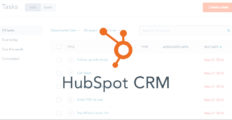









Leave a comment!